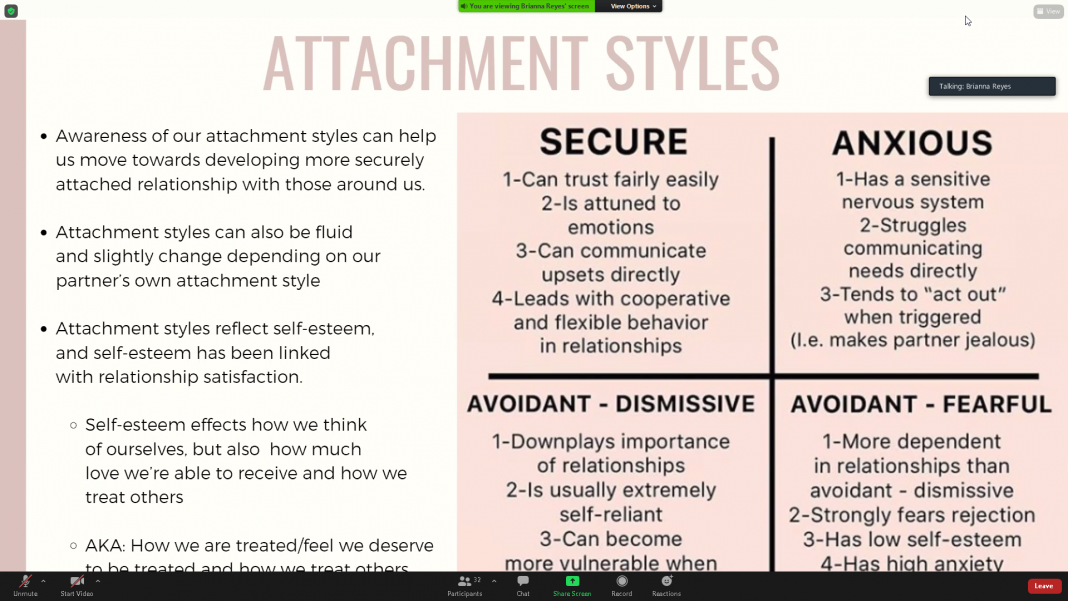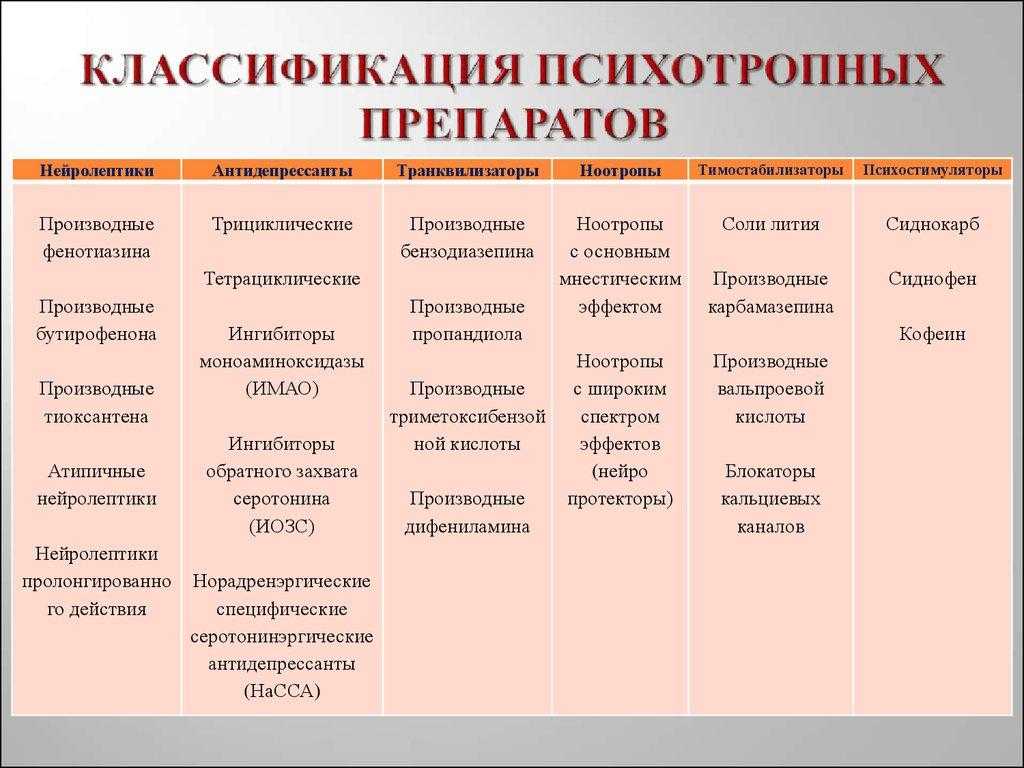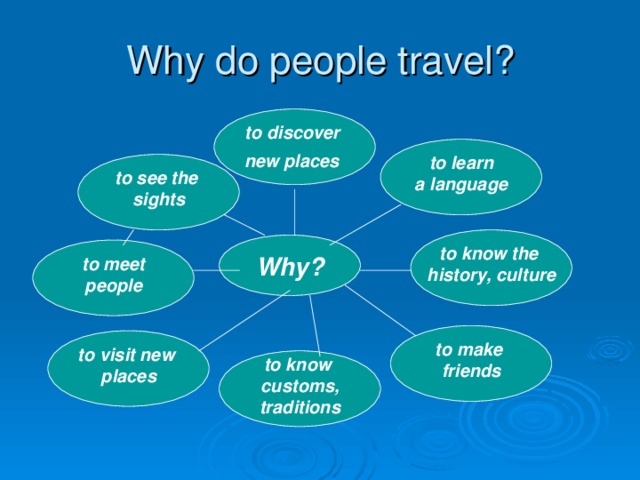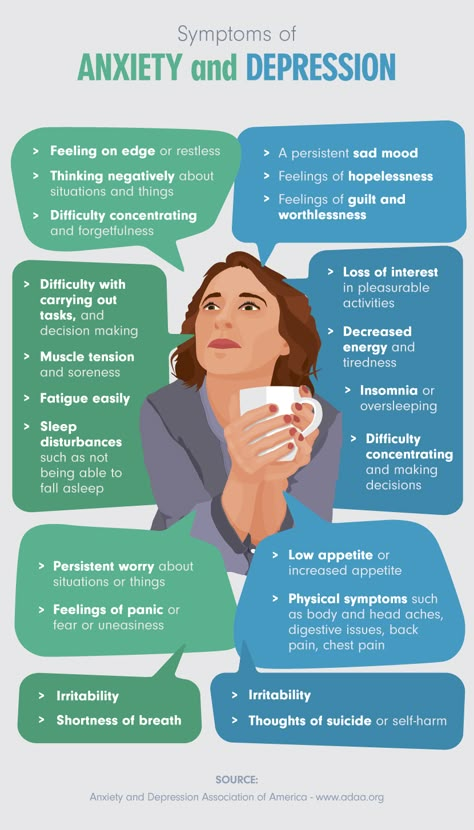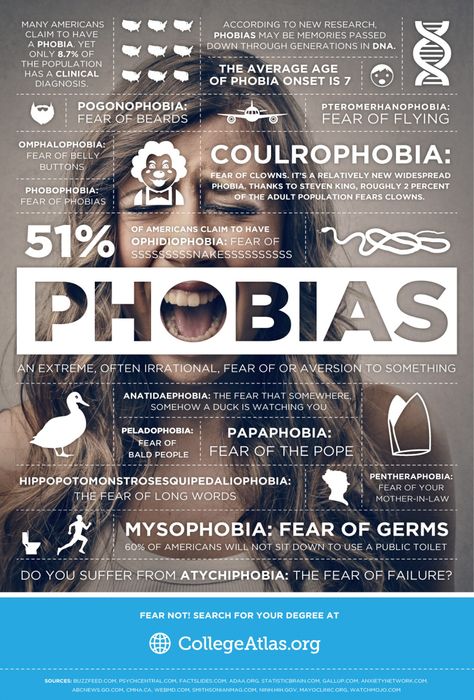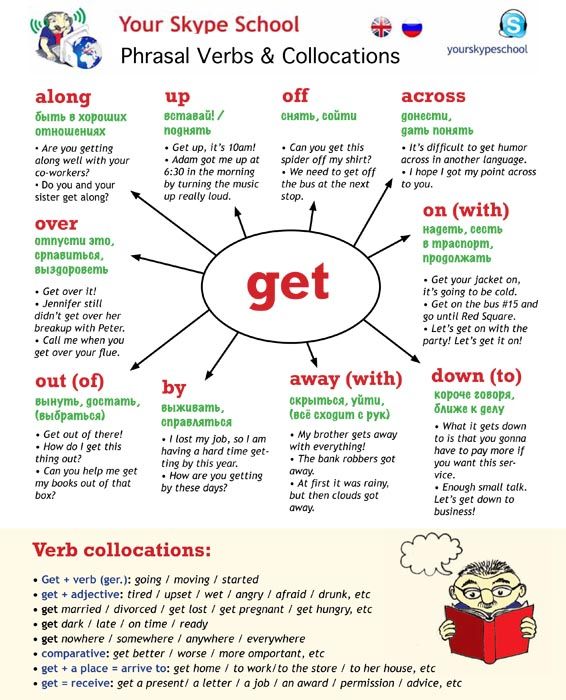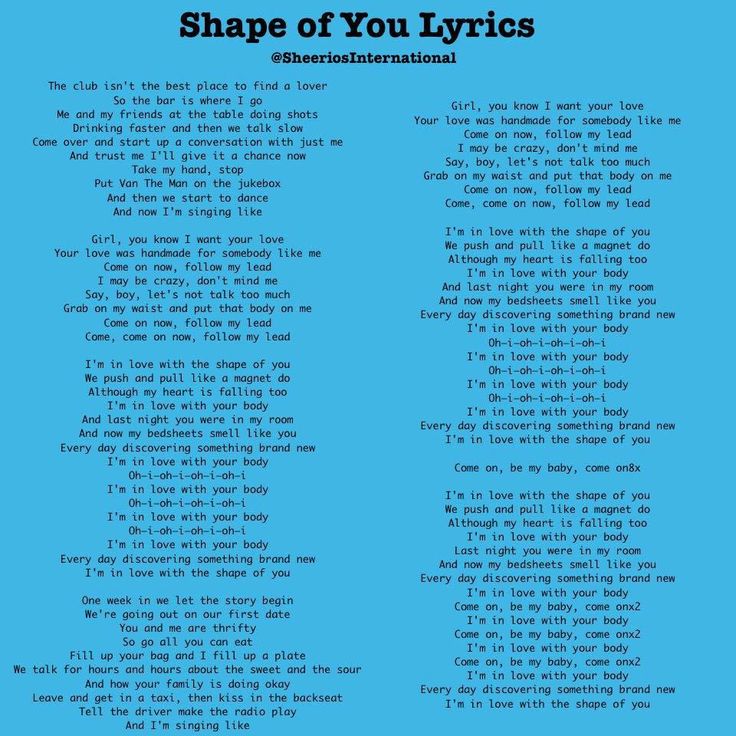Attachment styles are
Attachment Styles and Their Role in Adult Relationships
John Bowlby’s work on attachment theory dates back to the 1950’s. Based on his theory, four adult attachment styles were identified: 1. anxious-preoccupied, 2. avoidant-dismissive , 3. disorganized / fearful-avoidant, and 4. secure.
Attachment styles develop early in life and often remain stable over time.
People with insecure attachment styles might have to put some intentional effort into resolving their attachment issues, in order to become securely attached.
What are attachment styles and how do they affect our relationships?
It’s human nature to seek contact and relationships, to seek love, support, and comfort in others. In fact, according to social psychologist Roy Baumeister, the ‘need to belong’ is one of the main forces that drives individuals.
From an evolutionary perspective, cultivating strong relationships and maintaining them has both survival and reproductive advantages. After all, most of us do ‘need to belong’ and do want closeness and intimacy in our lives.
Yet, love and relationships are rarely as perfect and problem-free as we would like them to be.
Have you noticed repeating patterns in your love life?
Maybe you have never really thought through or analyzed your behavior in relationships. Still, you might have noticed repeating patterns in your love life.
Have you wondered why you keep ending up in the same situation, even with different partners?
Do you get too clingy or jealous? Or do you always seem to be more involved than your partner? Maybe you want to be with someone, but as soon as things get emotionally intimate, you back off?
If you have noticed a pattern of unhealthy and emotionally challenging behaviors in your love life, you might benefit from digging deep and exploring the way you attach to people in intimate relationships. Here is where knowing about attachment theory comes in handy.
What is attachment theory?
Attachment theory has a long history and has been used as a basis for continuous research.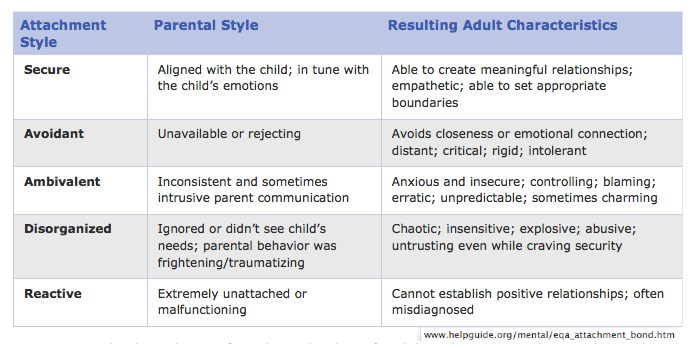 The first step is to get acquainted with the basics and understand the different attachment styles.
The first step is to get acquainted with the basics and understand the different attachment styles.
According to psychiatrist and psychoanalyst John Bowlby, one’s relationship with their parents during childhood has an overarching influence on their social, intimate relationships and even relationships at work in the future.
In other words, your early relationship with your caregivers sets the stage for how you will build relationships as an adult.
There are four adult attachment styles:
- Anxious (also referred to as Preoccupied)
- Avoidant (also referred to as Dismissive)
- Disorganized (also referred to as Fearful-Avoidant)
- Secure
Before getting into what characterizes the four groups, it might be useful to point out how attachment styles develop in children.
How do attachment styles develop in early childhood?
The behavior of the primary caregivers (usually one’s parents) contributes to and forms the way a child perceives close relationships.
The child is dependent on his or her caregivers and seeks comfort, soothing, and support from them. If the child’s physical and emotional needs are satisfied, he or she becomes securely attached.
This, however, requires that the caregivers offer a warm and caring environment and are attuned to the child’s needs, even when these needs are not clearly expressed.
Misattunement on the side of the parent, on the other hand, is likely to lead to insecure attachment in their children.
Which attachment style do you have? Take our free quiz now to find out!
Each one of the four attachment styles has its typical traits and characteristics.
Yet, a person does not necessarily fit 100% into a single category: you may not match ‘the profile’ exactly.
The point of self-analysis is to identify unhealthy behaviors and understand what you might need to work on in order to improve your love life. So, let’s get to it!
How does each of the four attachment styles manifest in adults?
1.
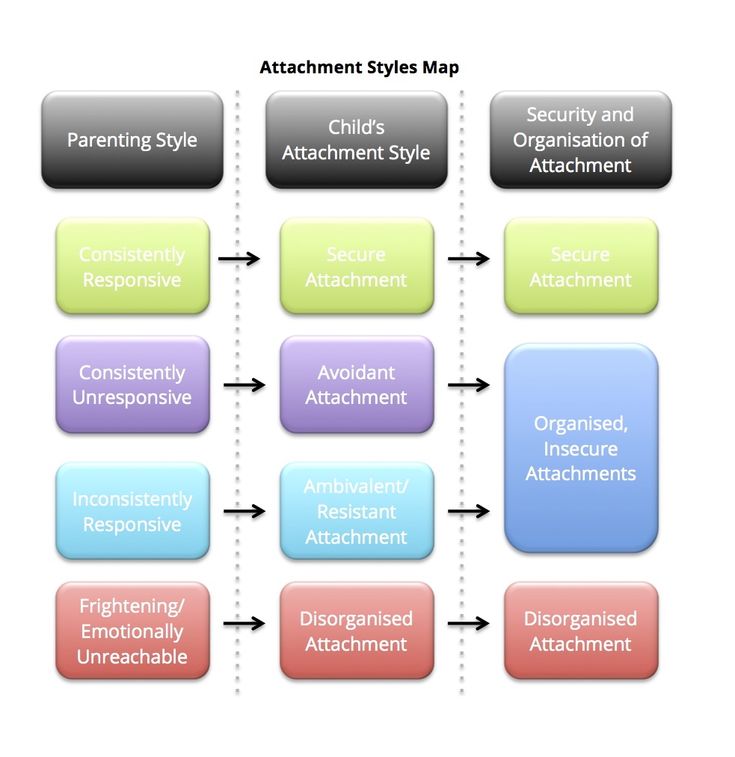 Anxious / Preoccupied
Anxious / PreoccupiedFor adults with an anxious attachment style, the partner is often the ‘better half.’
The thought of living without the partner (or being alone in general) causes high levels of anxiety. People with this type of attachment typically have a negative self-image, while having a positive view of others.
The anxious adult often seeks approval, support, and responsiveness from their partner.
People with this attachment style value their relationships highly, but are often anxious and worried that their loved one is not as invested in the relationship as they are.
A strong fear of abandonment is present, and safety is a priority. The attention, care, and responsiveness of the partner appears to be the ‘remedy’ for anxiety.
On the other hand, the absence of support and intimacy can lead the anxious / preoccupied type to become more clinging and demanding, preoccupied with the relationship, and desperate for love.
Want to know more about anxious attachment? Explore this attachment style by topic:
- Anxious Attachment deep dive (from childhood to adult relationships)
- Anxious Attachment in relationships guide
- Anxious Ambivalent Attachment (how anxious attachment develops in childhood)
- Self-regulation tips for anxious attachment (know your triggers and how to manage them)
- Attachment in the workplace
- The superpowers of adults with anxious attachment
2.
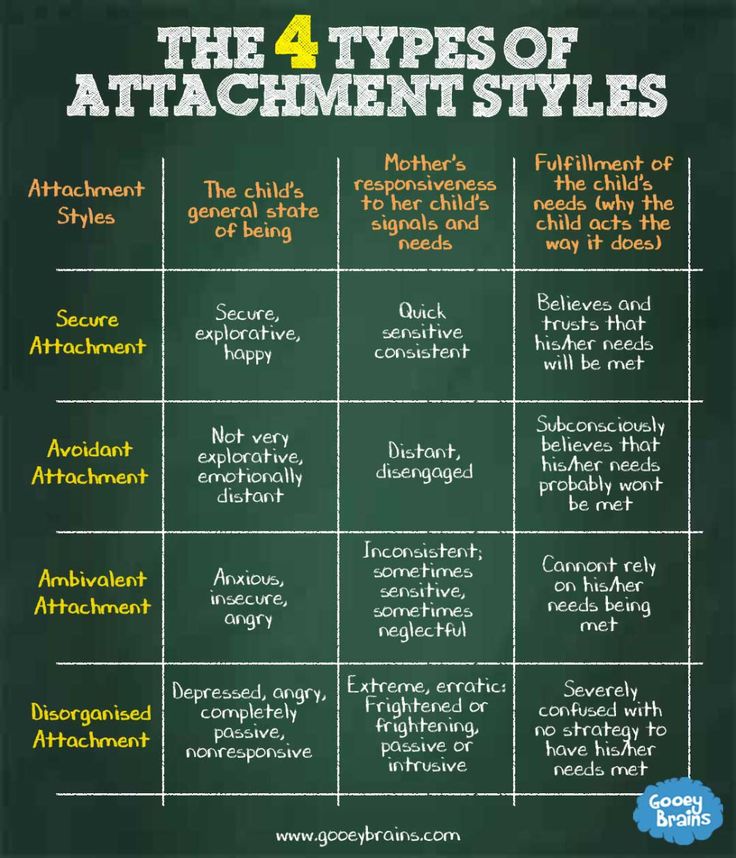 Avoidant / Dismissive
Avoidant / DismissiveThe dismissing / avoidant type would often perceive themselves as ‘lone wolves’: strong, independent, and self-sufficient; not necessarily in terms of physical contact, but rather on an emotional level.
These people have high self-esteem and a positive view of themselves.
The dismissing / avoidant type tend to believe that they don’t have to be in a relationship to feel complete.
They do not want to depend on others, have others depend on them, or seek support and approval in social bonds.
Adults with this attachment style generally avoid emotional closeness. They also tend to hide or suppress their feelings when faced with a potentially emotion-dense situation.
Want to know more about avoidant attachment? Explore this attachment style by topic:
- Avoidant Attachment deep dive (from childhood to adult relationships)
- Anxious Avoidant Attachment (how avoidant attachment develops in childhood)
- Self-regulation tips for avoidant attachment (know your triggers and how to manage them)
- Avoidant attachment and dating
- Avoidant attachment style and relationships
- The superpowers of adults with avoidant attachment
3.
 Disorganized / Fearful-Avoidant
Disorganized / Fearful-AvoidantThe disorganized type tends to show unstable and ambiguous behaviors in their social bonds.
For adults with this style of attachment, the partner and the relationship themselves are often the source of both desire and fear.
Fearful-avoidant people do want intimacy and closeness, but at the same time, experience troubles trusting and depending on others.
They do not regulate their emotions well and avoid strong emotional attachment, due to their fear of getting hurt.
Want to know more about disorganized attachment? Explore this attachment style by topic:
- Disorganized Attachment deep dive (from childhood to adult relationships)
- Fearful-Avoidant Attachment (how disorganized attachment develops in childhood)
- Self-regulation tips for adults with disorganized attachment
- Attachment in the bedroom
- Attachment in the workplace
- The superpowers of disorganized attachment
4.
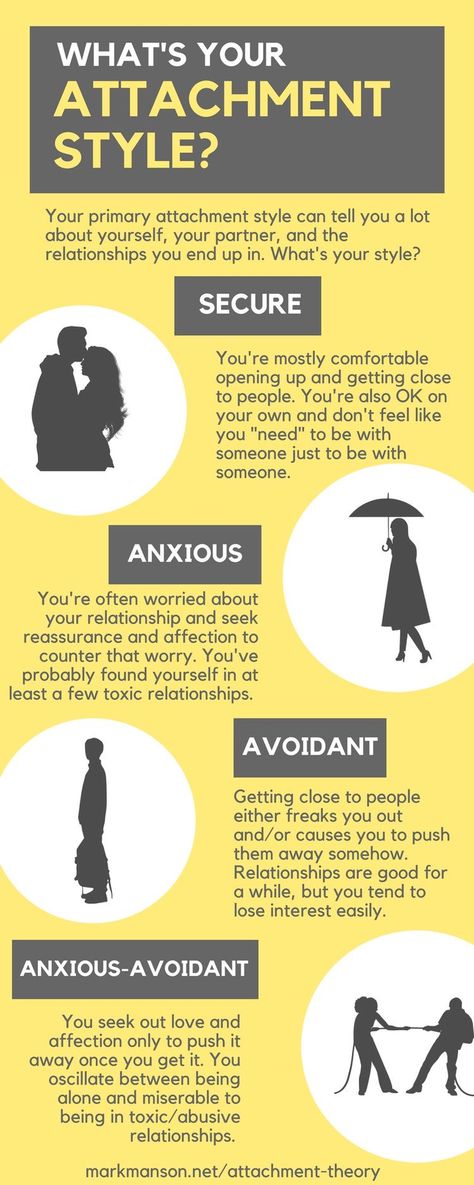 Secure Attachment
Secure AttachmentThe three attachment styles covered so far are insecure attachment styles.
They are characterized by difficulties with cultivating and maintaining healthy relationships.
In contrast, the secure attachment style implies that a person is comfortable expressing emotions openly.
Adults with a secure attachment style can depend on their partners and in turn, let their partners rely on them.
Relationships are based on honesty, tolerance, and emotional closeness.
The secure attachment type thrive in their relationships, but also don’t fear being on their own. They do not depend on the responsiveness or approval of their partners, and tend to have a positive view of themselves and others.
Want to know more about secure attachment? Explore this attachment style by topic:
- Secure Attachment deep dive (from childhood to adult relationships)
- Secure Attachment in childhood (the five conditions required)
- Attachment in the bedroom
- Attachment in the workplace
Where do you stand?
Now that you are acquainted with the four adult attachment styles, you probably have an idea of which one you lean towards.
It is completely normal to recognize features of different styles in your history of intimate relationships. Attachment styles can change with major life events, or even with different partners.
An insecurely attached individual could form a secure bond when they have a securely attached partner.
A person with a secure attachment style could, in contrast, develop an unhealthy relationship behavior after experiencing trauma or losing a loved one. So, there is no need to fit any specific profile.
When to worry?
Chances are that many of us don’t fully belong to the securely attached group.
Even if we think we have stable relationships, there might be patterns in our behavior that keep bothering us or keep making us stressed/unhappy.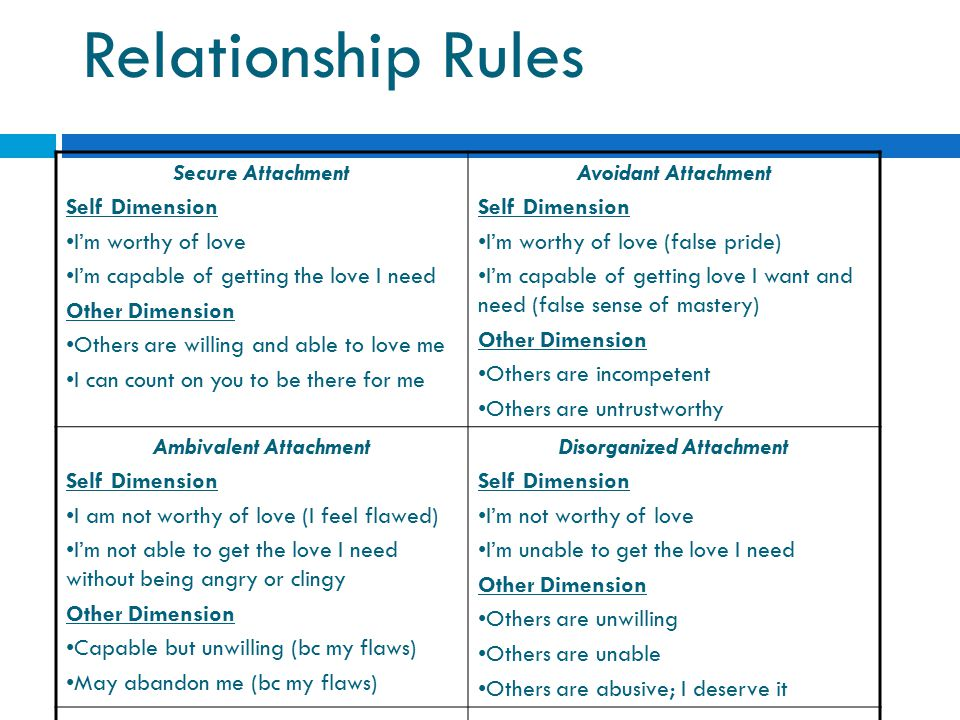 Unfortunately, some individuals will recognize themselves in one of the three insecure ‘profiles’ – the less healthy ones.
Unfortunately, some individuals will recognize themselves in one of the three insecure ‘profiles’ – the less healthy ones.
In that case, it is preferable and highly recommended that they address the issue actively and if necessary, seek individual psychological help.
But here’s the thing: this struggle is simply not necessary, as there are many ways to heal and recover from attachment disturbances.
Strongly expressed insecure and unstable attachment styles can cause anxiety, depression, and other mental health issues.
But here’s the thing: this struggle is simply not necessary, as there are many ways to heal and recover from attachment disturbances.
Are you:
- Tired of struggling with or ruining relationship after relationship?
- Embarrassed about being too clingy?
- Desperate for love and attention?
- Fed up with feeling anxiety over whether your partner loves you?
Ready to learn how to tolerate emotional intimacy and start trusting and relying on people?
Obviously, working with a therapist on this pattern would potentially be the most beneficial way to earn secure attachment. We are offering attachment repair groups and online courses for you to move forward.
We are offering attachment repair groups and online courses for you to move forward.
Either way, if you want to change your attachment style, you need to put effort in it. Whether you are working through it with a close friend, a therapist, or a book, consistency and effort are fundamental.
If you prefer to go the route of a workbook, we recently released our first series of attachment style digital workbooks.
Attachment Style Digital WorkbooksIf you’d like to use attachment theory to build better and more secure relationships with everyone around you, our workbooks are the perfect place to start!
Empower Your Instagram Feed
Want to learn more about attachment theory? We’re here to help you make sense of your attachment style in various contexts of your life. Follow The Attachment Project on Instagram.
View this post on Instagram
View this post on Instagram
View this post on Instagram
Sources:
Baumeister, R. F., & Leary, M. R. (1995). The need to belong: Desire for interpersonal attachments as a fundamental human motivation. Psychological Bulletin, 117(3), 497-529.
Mikulincer, M., Shaver, P.R. (2007). Attachment in Adulthood: Structure, Dynamics, and Change. Guilford Press.
What Is Your Attachment Style? Attachment Theory, Explained
What is an attachment style?
An attachment style is a specific pattern of behavior in and around relationships.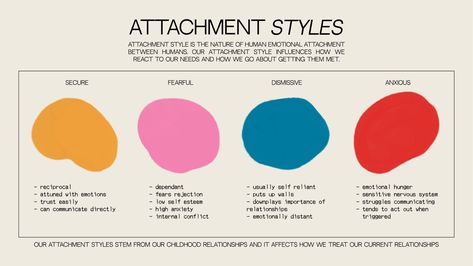 There are four adult attachment styles: secure attachment, anxious attachment, avoidant attachment, and fearful-avoidant (aka disorganized) attachment.
There are four adult attachment styles: secure attachment, anxious attachment, avoidant attachment, and fearful-avoidant (aka disorganized) attachment.
According to attachment theory, first developed by psychologist Mary Ainsworth and psychiatrist John Bowlby in the 1950s, a person's attachment style is shaped and developed in early childhood in response to their relationships with their earliest caregivers. Essentially, our adult attachment style is thought to mirror the dynamics we had with our caregivers as infants and children.
Attachment style includes the way we tend to respond emotionally to others, how we usually interact with partners in relationships, and how we behave when it comes to relationships in general, according to therapist Alyssa "Lia" Mancao, LCSW.
Some research measures the four attachment styles based on an individual's levels of avoidance and anxiety in relationships, as seen in the chart below:
Graphic by mbg Creative / Contributor
Advertisement
This ad is displayed using third party content and we do not control its accessibility features.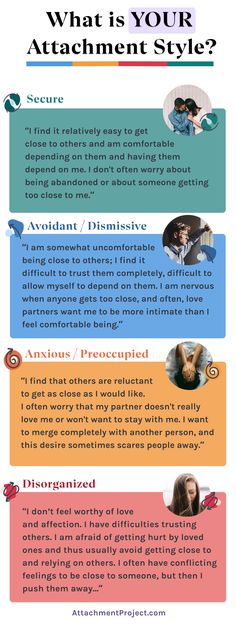
The four attachment styles:
1.
Secure attachment
Secure attachment style refers to the ability to form secure, loving relationships with others. A person with a secure attachment style is able to trust others and be trusted, love and accept love, and become close to others with relative ease. They're not afraid of intimacy, nor do they feel panicked when their partners need time or space away from them. They're able to depend on others without becoming totally dependent.
About 56% of adults have a secure attachment type, according to foundational attachment research by social psychologists Cindy Hazan and Phillip Shaver in the 1980s.
Secure attachment is considered the healthy ideal for relationships. All other attachment styles that are not secure are known as insecure attachment styles.
Find your match today with eHarmony. Free to join.
2.
Anxious attachment
Anxious attachment style is a type of insecure attachment style marked by a deep fear of abandonment.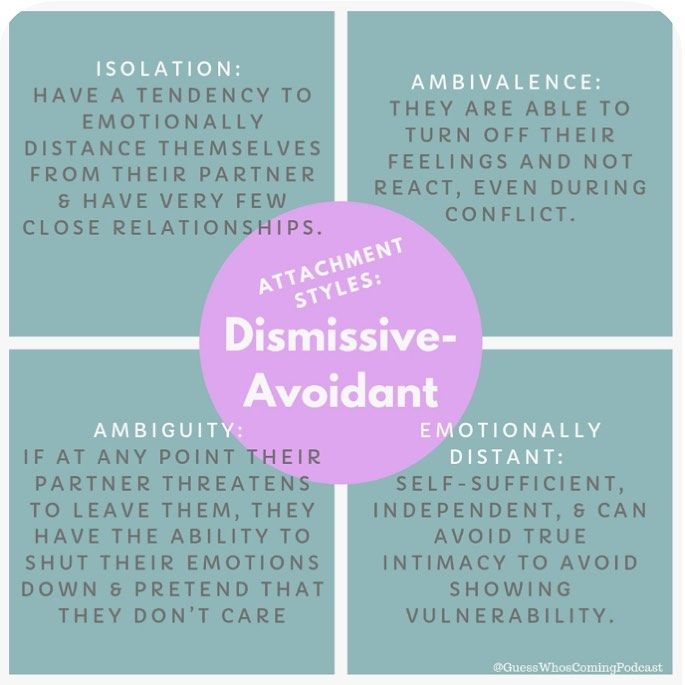 People with an anxious attachment style tend to be very insecure about their relationships, often worrying that their partner will leave them and thus always hungry for validation.
People with an anxious attachment style tend to be very insecure about their relationships, often worrying that their partner will leave them and thus always hungry for validation.
Anxious attachment is associated with "neediness" or clingy behavior in relationships, such as getting very anxious when your partner doesn't text back fast enough and constantly feeling like your partner doesn't care enough about you.
Anxious attachment is also known as anxious-preoccupied attachment, and it generally aligns with the anxious-ambivalent attachment style or anxious-resistant attachment style observed among children. Some 19% of adults have the anxious attachment type, according to Hazan and Shaver's research.
3.
Avoidant attachment
Avoidant attachment style is a type of insecure attachment style marked by a fear of intimacy. People with an avoidant attachment style tend to have trouble getting close to others or trusting others in relationships, because they ultimately don't believe their needs can get met in a relationship.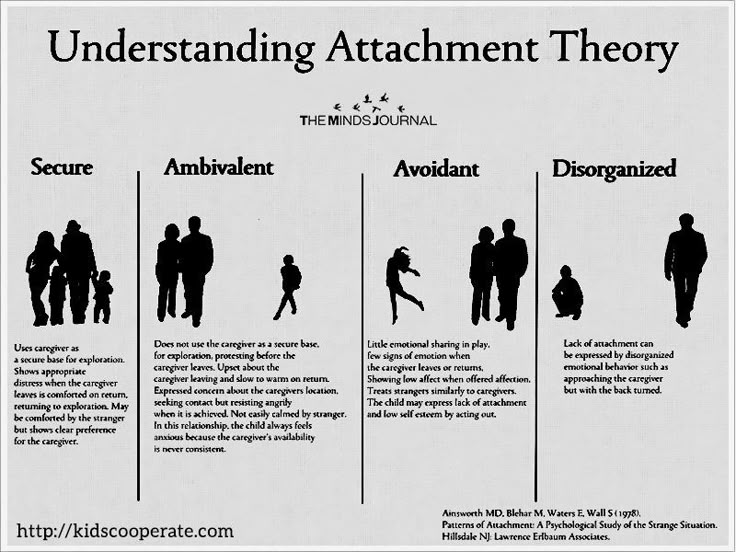
In relationships, avoidant people typically maintain some distance from their partners or are largely emotionally unavailable. They may even find relationships suffocating and avoid them completely, preferring to be independent and rely on themselves.
Avoidant attachment is also known as dismissive-avoidant attachment, and it generally aligns with the anxious-avoidant attachment style observed among children. Some 25% of adults have the avoidant attachment type, according to Hazan and Shaver.
Advertisement
This ad is displayed using third party content and we do not control its accessibility features.
4.
Fearful-avoidant attachment (aka disorganized)
Fearful-avoidant attachment style is a combination of both the anxious and avoidant attachment styles. People with fearful-avoidant attachment both desperately crave affection and want to avoid it at all costs. They're reluctant to develop a close romantic relationship, yet at the same time, they feel a dire need to feel loved by others.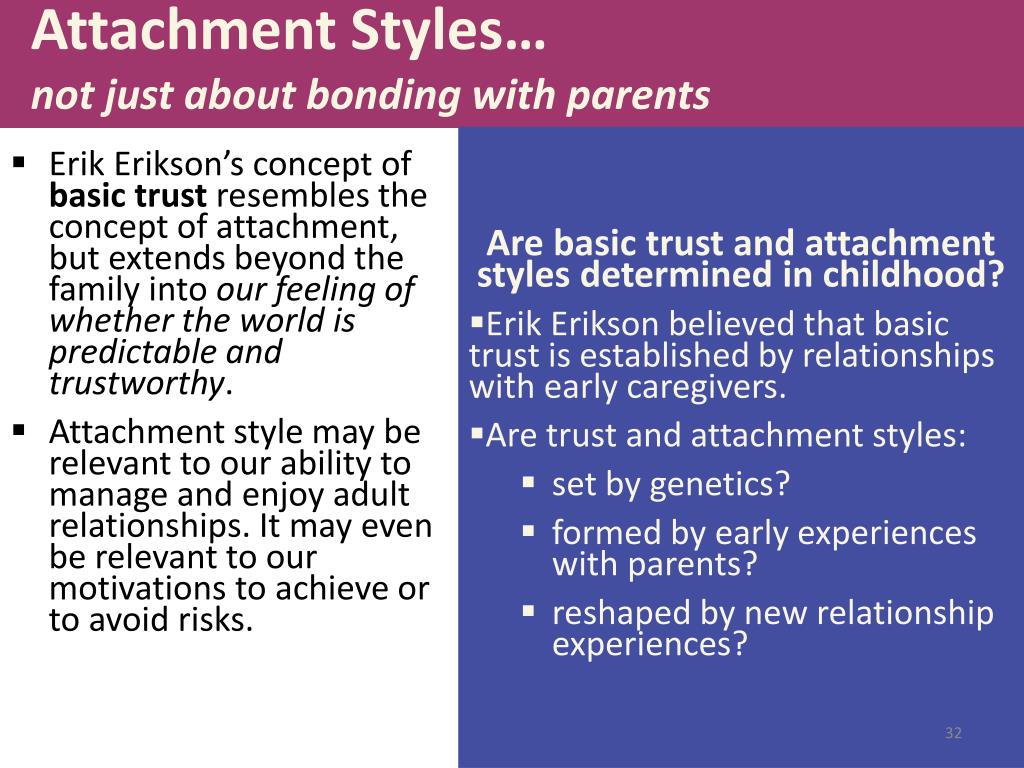
Fearful-avoidant attachment is also known as disorganized attachment, because the attachment behaviors display by these individuals can seem inconsistent and oscillate between the extremes of avoidance and anxiousness.
In general, the fearful-avoidant attachment style is relatively rare and not well-researched. But we do know it's associated with significant psychological and relational risks1, including difficulty regulating emotions, heightened sexual behavior, and increased risk for violence in their relationships.
Advertisement
This ad is displayed using third party content and we do not control its accessibility features.
The attachment styles quiz.
Below are the descriptions of the main attachment types used in Hazan and Shaver's foundational research on attachment theory. Read the statements and pick the one that most resonates with you:
- I find it relatively easy to get close to others and am comfortable depending on them and having them depend on me.
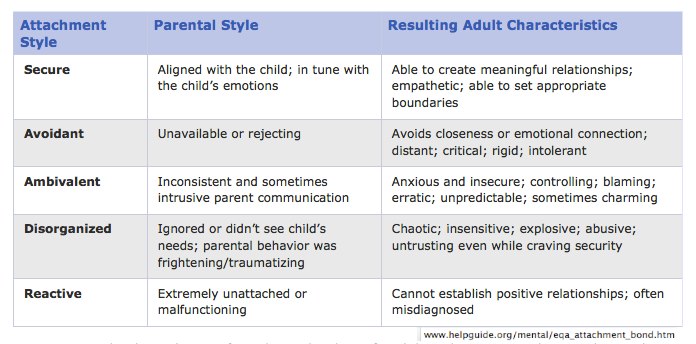 I don't often worry about being abandoned or about someone getting too close to me.
I don't often worry about being abandoned or about someone getting too close to me. - I find that others are reluctant to get as close as I would like. I often worry that my partner doesn't really love me or won't want to stay with me. I want to merge completely with another person, and this desire sometimes scares people away.
- I am somewhat uncomfortable being close to others; I find it difficult to trust them completely, difficult to allow myself to depend on them. I am nervous when anyone gets too close, and often, love partners want me to be more intimate than I feel comfortable being.
Advertisement
This ad is displayed using third party content and we do not control its accessibility features.
Once you've picked the number you most resonate with, scroll back up to the descriptions of each attachment style in the previous section of this article. The number you picked here corresponds with your attachment style in the list up there. (Note: Fearful-avoidant attachment, the fourth and rarest attachment type, was not studied in Hazan and Shaver's research and is not included in this mini attachment quiz.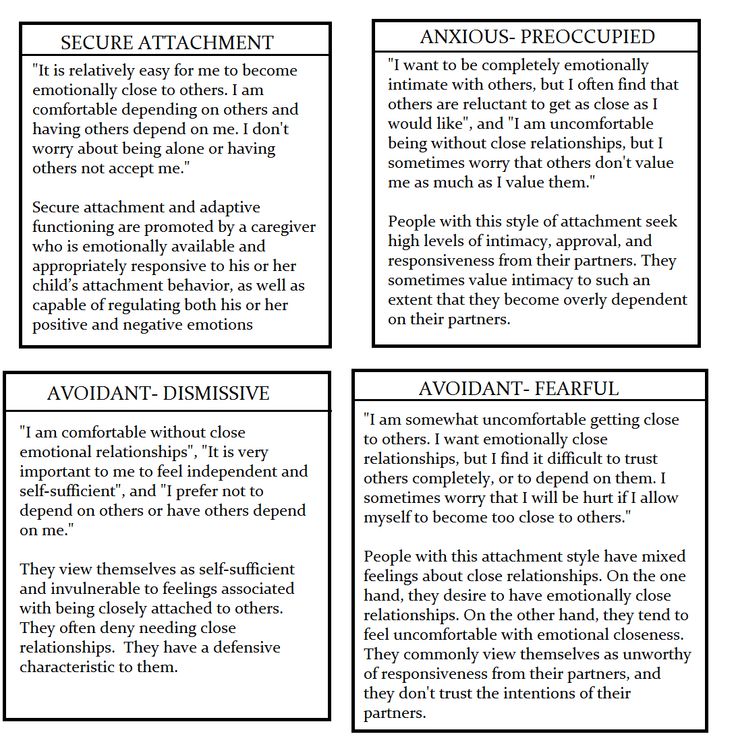 The two more detailed quizzes below can tell you if this may be your attachment type.)
The two more detailed quizzes below can tell you if this may be your attachment type.)
Here are two more attachment style quiz options to try:
- A simple, five-minute attachment style quiz developed by mindbodygreen
- A longer attachment survey created by R. Chris Fraley, Ph.D., a psychologist at the University of Illinois who has researched attachment theory in depth. His test is more involved and based on the parameters studied in the scientific research.
eHarmony.com
Join eHarmony to find someone who matches your attachment style. (Ad)
How attachment styles are formed.
Attachment styles are typically developed in infancy based on our relationships with our earliest caregivers. Researchers believe attachment style is formed within our first year of living, between 7 to 11 months of age, according to mental health counselor Grace Suh, LMHC, LPC. According to Mancao, it's "determined by how the primary caregiver responds to the child's cues when they are experiencing emotional stress. "
"
"Human beings are born helpless, so we are hardwired at birth to search for and attach to a reliable caregiver for protection," Peter Lovenheim, author of The Attachment Effect, writes at mbg. "The quality of that first bond—loving and stable or inconsistent or even absent—actually shapes the developing brain, influencing us throughout life in how we deal with loss and how we behave in relationships."
Here's a quick primer on what circumstances lead to each of the four attachment types:
- Secure attachment: Caregivers are responsive and attuned to their child's needs, says Mancao.
- Anxious attachment: "Caregivers are inconsistent, unpredictable with affections, sometimes overly involved, and intermittently withdrawn," says Suh. It's the unpredictable fluctuation between caregivers being emotionally available and then distant that leads children to be anxious about all their future relationships, Mancao adds.
- Avoidant attachment: Caregivers are not responsive, and they are often dismissive and distant, Suh explains.
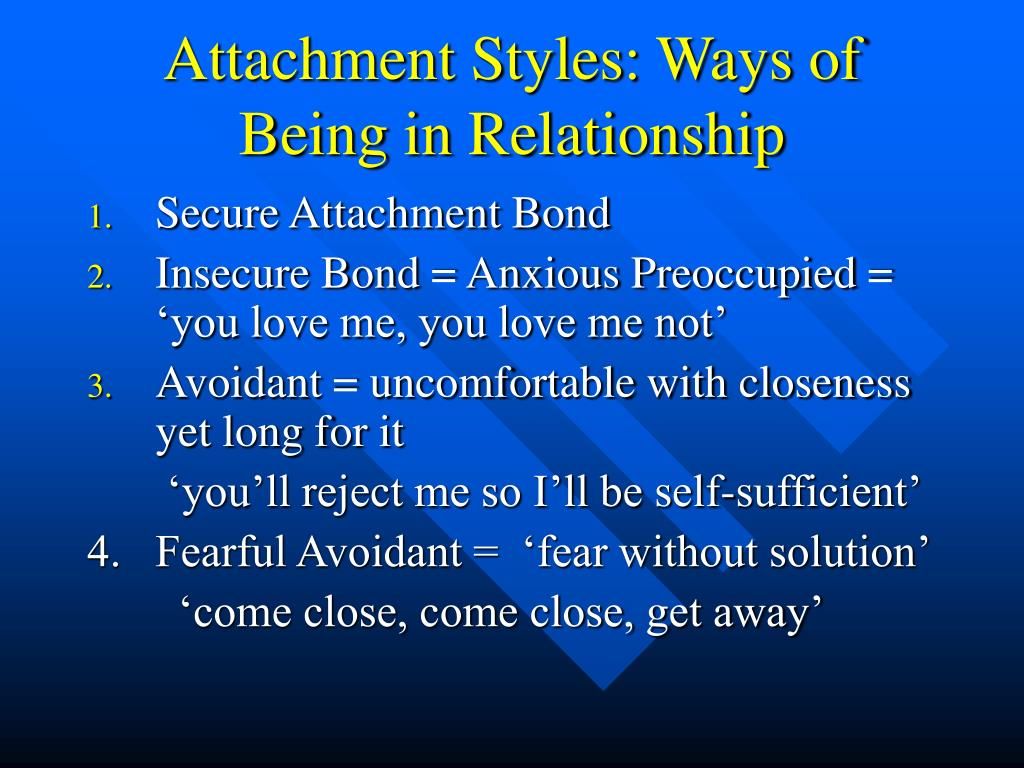 They're consistently emotionally disconnected from their child, "resulting in the child believing that their needs won't get met," Mancao says.
They're consistently emotionally disconnected from their child, "resulting in the child believing that their needs won't get met," Mancao says. - Fearful-avoidant attachment: "The type of an environment that influences a disorganized attachment involves a caregiver who is frightening or traumatizing, leading to the child to experience a deep sense of fear and a lack of trust in others despite wanting close connections," Mancao says. They may be neglectful or even abusive, Suh adds, such that the child develops a "poor understanding of boundaries" and is "confused about what a healthy relationship looks like."
Caregivers are not the only ones who shape your attachment style, however. People's attachment styles may also be influenced by other significant relationships throughout their lives, such as friendships and past romantic relationships. "A person can have had a secure attachment during childhood; however, betrayals and infidelity in adulthood can lead to an insecure attachment," says Mancao.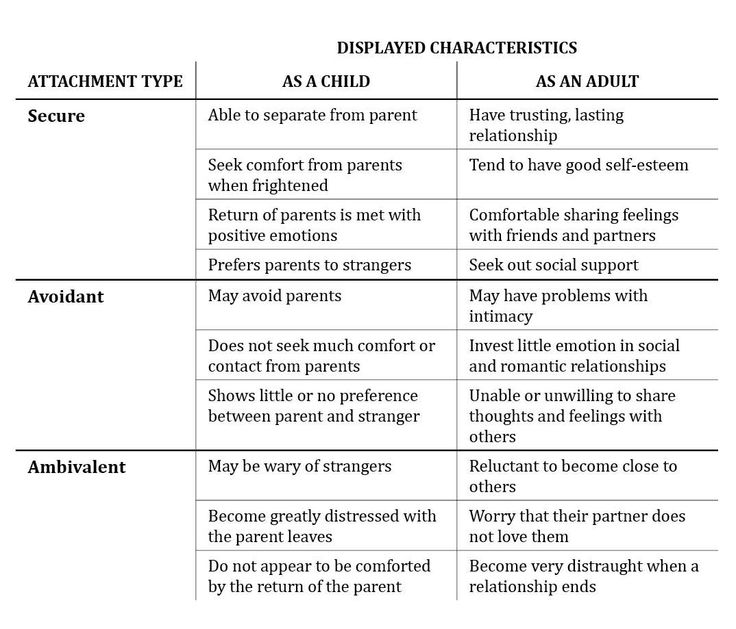
It's also possible to have a different attachment style in different situations, according to Mancao. "While we may have a primary attachment style, depending on our relationships, we may feel more secure with one person than we do with another," she explains. "For many people, their attachment style is not the same in every relationship they encounter. Things that contribute to this are their counterpart's (romantic or platonic) personality and feelings of safety."
The history of attachment theory research.
Although often referenced as "Bowlby's attachment theory," attachment theory as we know it today was developed by several researchers over the course of the late 20th century. British psychoanalyst John Bowlby developed the concept of attachment behaviors around the 1950s. His theory was that children's tendency to emotionally attach to their caregivers and to become distressed and seek them out in their absence was an adaptive evolutionary trait, something that allowed children to survive by clinging to an attachment figure who provided support, protection, and care when they were too young to care for themselves.
Mary Ainsworth, a psychologist and one of Bowlby's colleagues, expanded on Bowlby's original attachment theory by identifying individual differences in how infants handled separations from their parents. Her famous "strange situation" experiment in 1969 identified four attachment types among infants: secure, anxious-resistant, avoidant, and disorganized.
Later in the 1980s, social psychologists Cindy Hazan and Phillip Shaver began to apply Ainsworth and Bowlby's attachment theory to adult romantic relationships, giving birth to the concept of the adult attachment styles we know today. In 1998, research psychologist Kelly Brennan and her colleagues further expanded on adult attachment, demonstrating two distinct dimensions that shape attachment patterns: attachment-related anxiety and attachment-related avoidance. People can be low in both, high in one and low in the other, or high in both, which determines their attachment style. (See above graphic.)
Today, there's some criticism of attachment theory among psychologists who say it's a stretch to believe caregivers can so dramatically shape infants' future relationships from such a young age.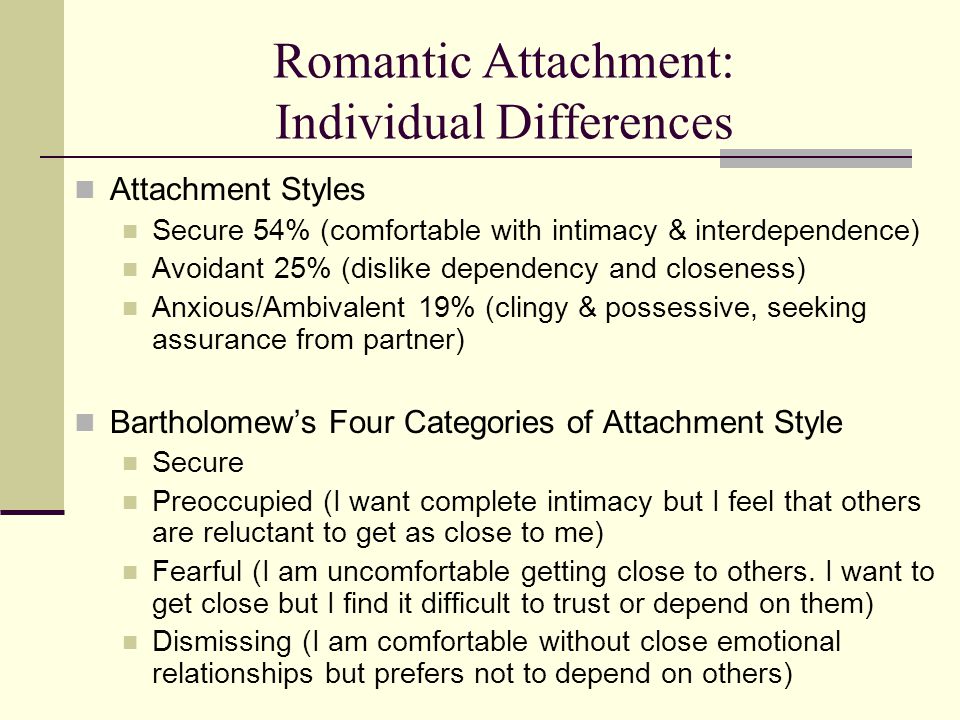 Indeed, thus far, studies attempting to draw a line between infant attachment patterns and their adult attachment styles have only found "small to moderate" correlations, according to Fraley himself. "Based on these kinds of studies, it seems likely that attachment styles in the child-parent domain and attachment styles in the romantic relationship domain are only moderately related at best," Fraley writes in a University of Illinois article.
Indeed, thus far, studies attempting to draw a line between infant attachment patterns and their adult attachment styles have only found "small to moderate" correlations, according to Fraley himself. "Based on these kinds of studies, it seems likely that attachment styles in the child-parent domain and attachment styles in the romantic relationship domain are only moderately related at best," Fraley writes in a University of Illinois article.
But the concept of attachment styles is enduring for a reason: It gives people language to describe the distinct ways they show up in their relationships, and it challenges them to look to their past experiences to help them understand why they are the way they are.
Mary Ainsworth and the strange situation.
In 1969 and subsequent years, psychologist Mary Ainsworth and her colleagues ran experiments known as The Strange Situation that identified and observed attachment behaviors in children. Her team brought mothers and their infants into the lab and had them play in a room with toys on the floor and with various other adults coming in and out of the room.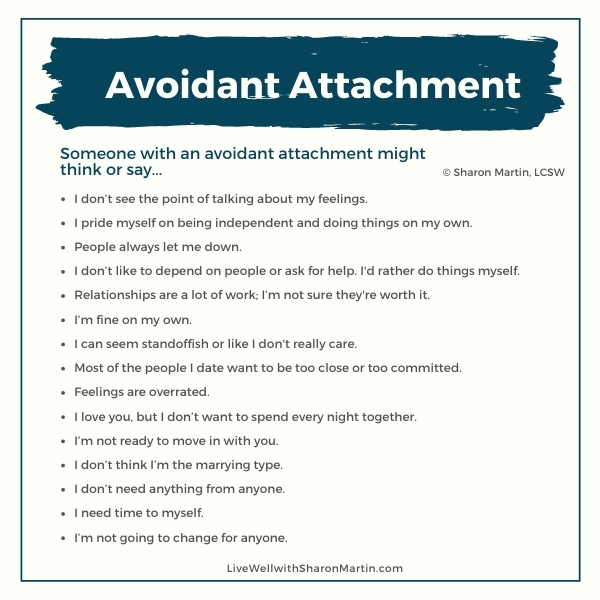 At some point, the mothers would get up and leave the room without their child. After a while, they'd return. The researchers wanted to observe how children responded first to their caregiver leaving and later to their caregiver returning to them.
At some point, the mothers would get up and leave the room without their child. After a while, they'd return. The researchers wanted to observe how children responded first to their caregiver leaving and later to their caregiver returning to them.
Here are some of the patterns they observed:
- Some children explored and played freely when their mother was in the room, became distressed when she left, and then were able to be soothed and comforted upon her return. These children were labeled as securely attached.
- Some children tended to avoid or ignore mothers even before she left and showed little emotion when left and when she returned. Ainsworth and her colleagues hypothesized that this avoidant behavior masked their true distress, and some further research tracking avoidant infants' heart rates confirmed this theory. These children were labeled as anxious-avoidant.
- Some children were already a bit distressed before the mother left, showed significant distress when she did, and were hard to comfort when she returned.
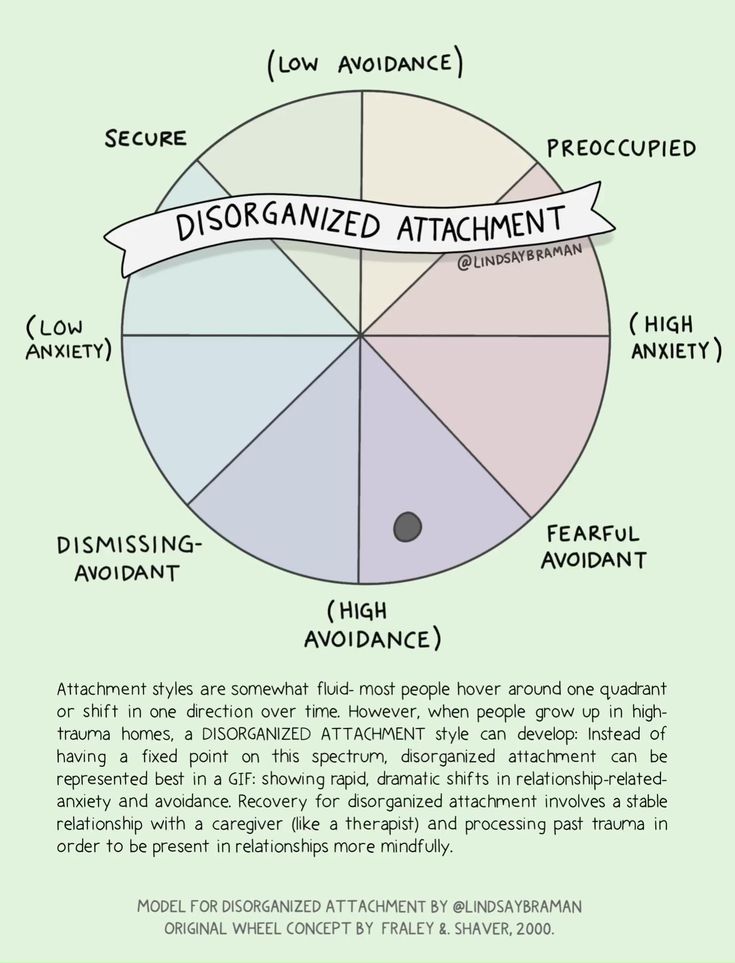 The researchers sometimes observed a desire to "punish" their mothers for leaving by continuing to act out despite being relieved that she'd returned. These children were labeled anxious-ambivalent or anxious-resistant.
The researchers sometimes observed a desire to "punish" their mothers for leaving by continuing to act out despite being relieved that she'd returned. These children were labeled anxious-ambivalent or anxious-resistant. - Finally, some children showed largely inconsistent behaviors, including general aimlessness throughout the experiment, fear of the caregiver, or even aggressiveness toward them. Sometimes they'd have these moments of out-of-place behaviors and then fall into one of the other categories, or they'd be a mix of several. These children were labeled as having disorganized attachment.
FAQs:
What are the 4 attachment styles?
The four attachment styles are secure, anxious, avoidant, and fearful-avoidant (also known as disorganized). The latter three are all considered types of insecure attachment.
What is the most common attachment style?
The most common attachment style is secure.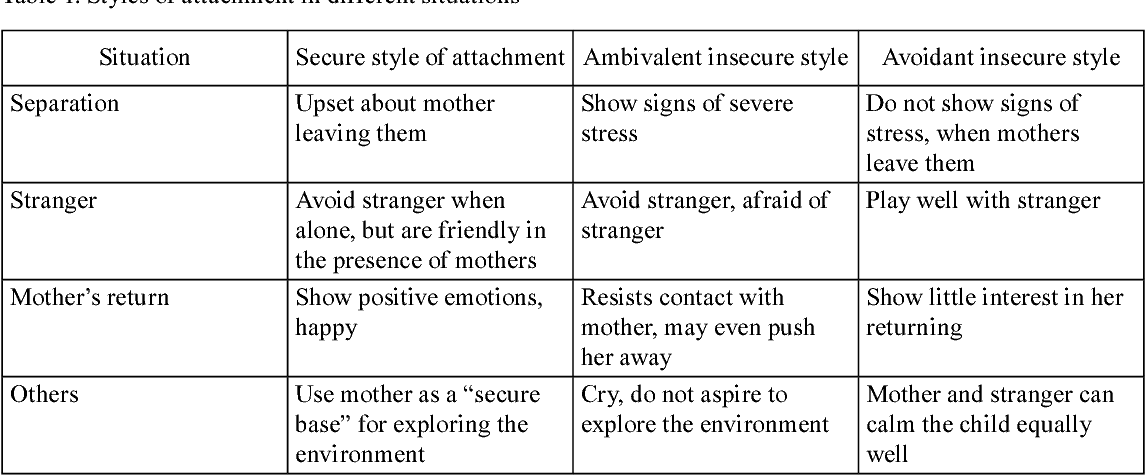 Foundational attachment research from the 1980s found approximately 56% of adults have a secure attachment style.
Foundational attachment research from the 1980s found approximately 56% of adults have a secure attachment style.
What is the rarest attachment style?
The rarest attachment style is the fearful-avoidant type, which is actually a combination of the anxious and avoidant attachment styles.
What is the unhealthiest attachment style?
The fearful-avoidant attachment style is often thought to be the most difficult, and it's the attachment style most linked with psychological and relational difficulties. However, all three insecure attachment styles (avoidant, anxious, and fearful-avoidant) tend to struggle in relationships in their own ways. Secure attachment often considered the healthy ideal to aspire toward in relationships.
Are avoidants insecure?
The avoidant attachment style is actually a form of insecure attachment, so in that sense, yes, avoidants are insecure. People with this attachment style form insecure attachments with others or avoid attachment completely because they fear their needs can't or won't be met in relationships.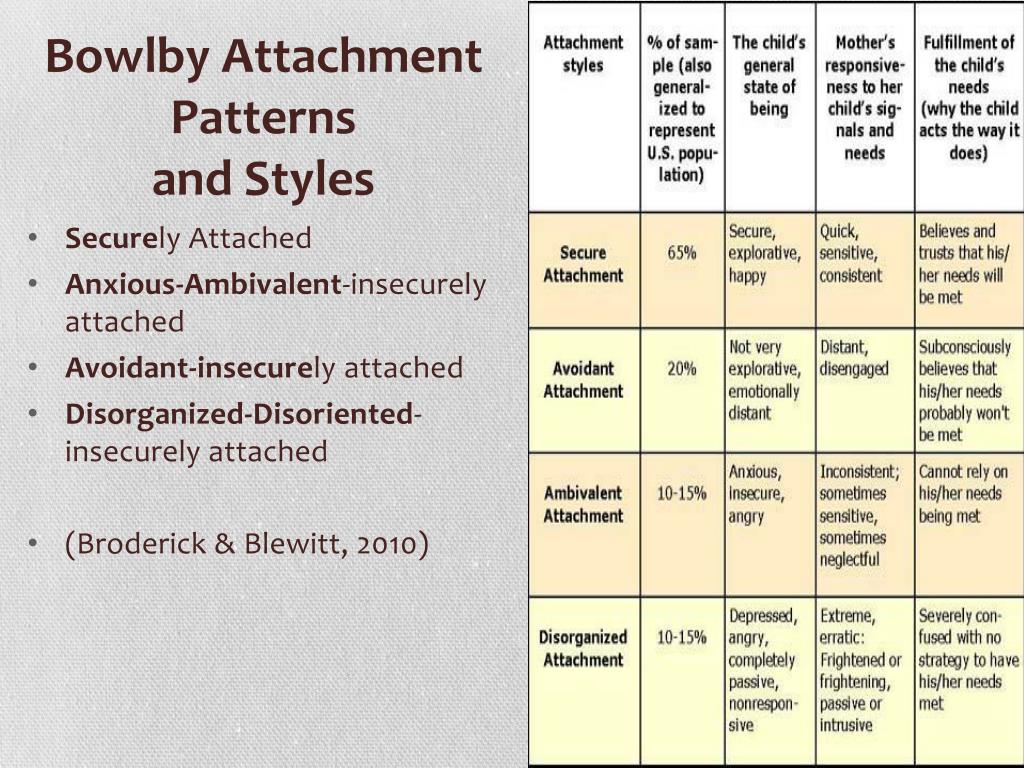
What attachment style is clingy?
The anxious attachment style is most associated with clingy behavior in relationships, although people with a fearful-avoidant attachment can also display some of these anxious tendencies.
Can your attachment style change?
"Yes, it is possible for a person to change their attachment style," Mancao says. "However, this takes a lot of work, patience, and intention if a person is shifting from an insecure to a secure attachment strategy."
How to change your attachment style.
1.
Identify your relationship patterns.
Start by thinking about your relationship with your parents as a child, says Suh. She recommends asking yourself questions like:
- How were they toward you as a child?
- How did you respond to them?
- To whom did you go for comfort when you had a problem?
- Were they negligent or reliable?
This will help you get more clarity on what may have shaped your attachment style.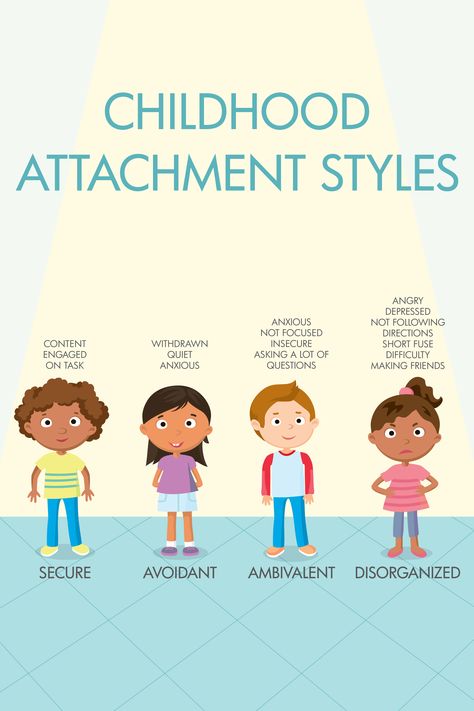
"Assess your current and past attachment style and identify if there are any patterns in choosing romantic partners," Suh says. "Be aware of your childhood history; the familiarity is comforting, whether it was good or bad. Meaning, your past unhealthy relationship patterns from childhood can recreate in adulthood."
2.
Work on your self-esteem.
Low self-esteem is a common characteristic across all insecure attachment styles, says Suh.
"Learn to embrace, value, love, and care for yourself first," she recommends. "If you cannot fathom what self-love is because you were neglected, abused, and dismissed as a child, you can start with self-tolerance and self-neutrality. This can look like, 'I'm a person, and everyone deserves to be valued' instead of forcing yourself with empty words of, 'I'm beautiful and valuable.'"
(Here's more on learning to love yourself, plus how to raise your self-esteem after a breakup specifically.)
3.
Get in touch with your real needs.
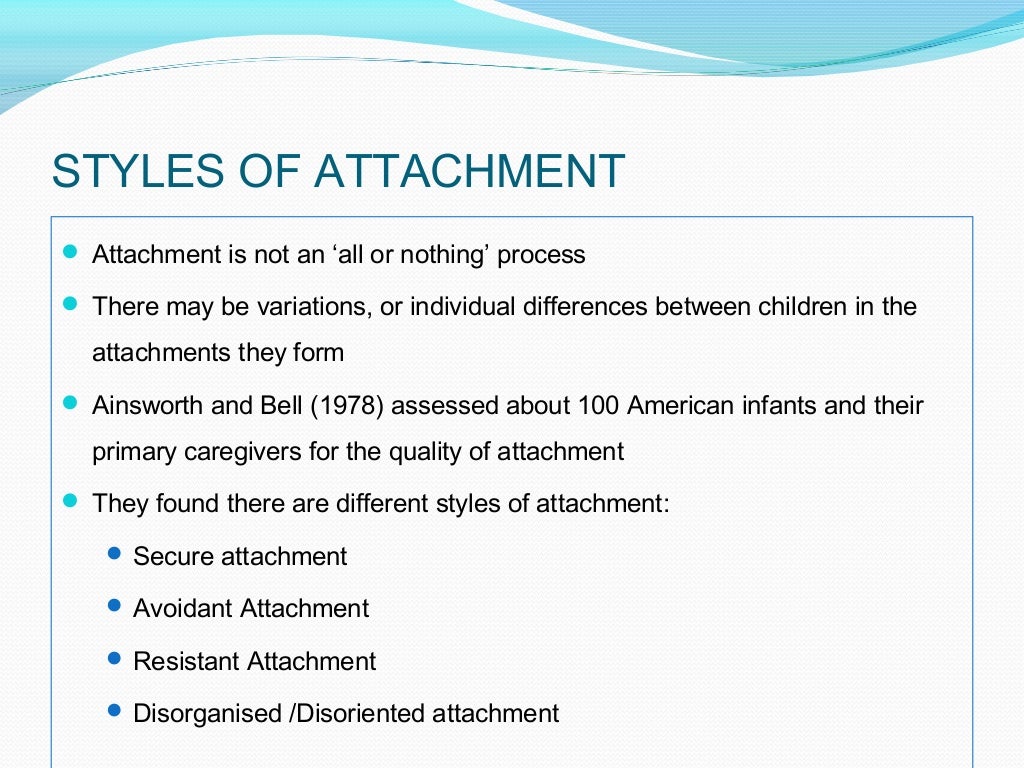
At the end of the day, all insecure attachment styles are people who tend to form insecure relationships because of deeply held fears that their relationships will not work out. So it's important to figure out how to make yourself feel more secure in your relationships. Part of that involves being aware of what your needs and desires are in relationships.
"Learn to be assertive and set boundaries. Honor what you feel, and express your needs in words without manipulation and hidden meanings," Suh says. "Securely attached people are often direct and appropriately confrontational to create a healthy and meaningful relationship."
4.
Don't be afraid to seek therapy.
"Therapy is helpful, both individual and couples," Suh says. "A quality therapist will help you to dive into your attachment style, past wounds, ways to identify, establish appropriate boundaries, and promote a healthy relationship."
Read more stellar mbg stories:
4 styles of attachment | PSYCHOLOGIES
87,273
Knowing Yourself A Human Among Humans
Attachment depends on our ability to trust ourselves and others.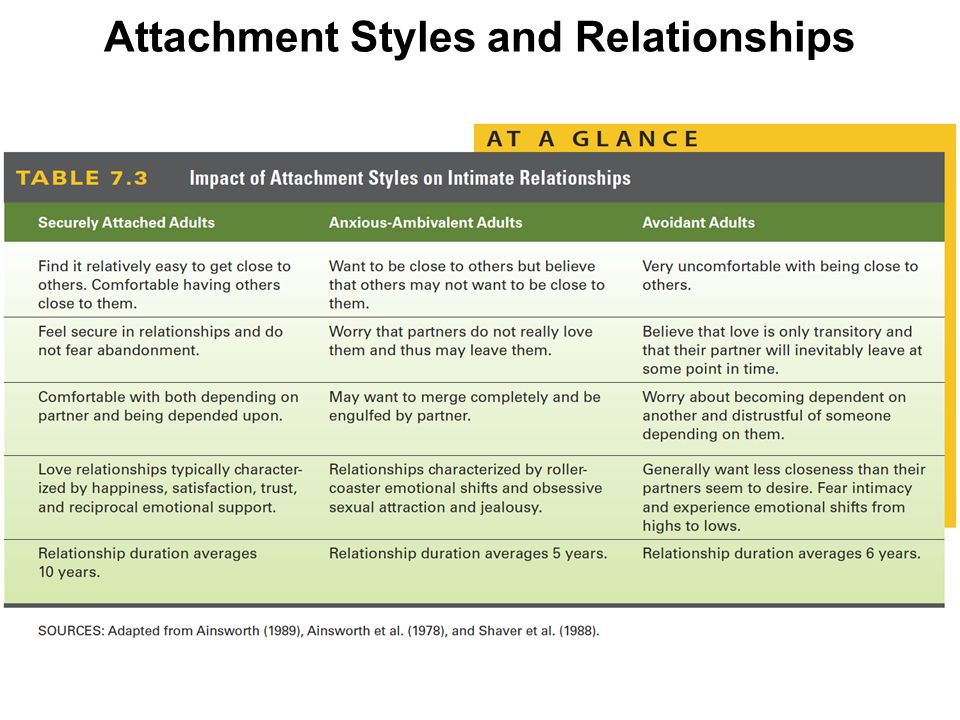 It develops from the moment of birth: the baby becomes attached to a significant adult who cares for him - most often this is the mother, although not necessarily her. And from this adult, the child expects protection and support when he experiences anxiety. Moreover, attachment to him arises in any case, even if an adult is deprived of sensitivity or inattentive. nine0003
It develops from the moment of birth: the baby becomes attached to a significant adult who cares for him - most often this is the mother, although not necessarily her. And from this adult, the child expects protection and support when he experiences anxiety. Moreover, attachment to him arises in any case, even if an adult is deprived of sensitivity or inattentive. nine0003
The child does not have the opportunity to choose relationships, so he has to adapt to those in which he already finds himself. And the emotional habits and reactions that have arisen in them influence his future: they largely determine what his relationships with other people will become in adulthood. The closer and closer the relationship, for example, romantic, the brighter the features of childish affection will appear in them.
John Bowlby, based on the work of child psychoanalyst Donald Winnicott, developed a theory that describes the main styles of attachment. According to the description, everyone can recognize the one that is peculiar to him.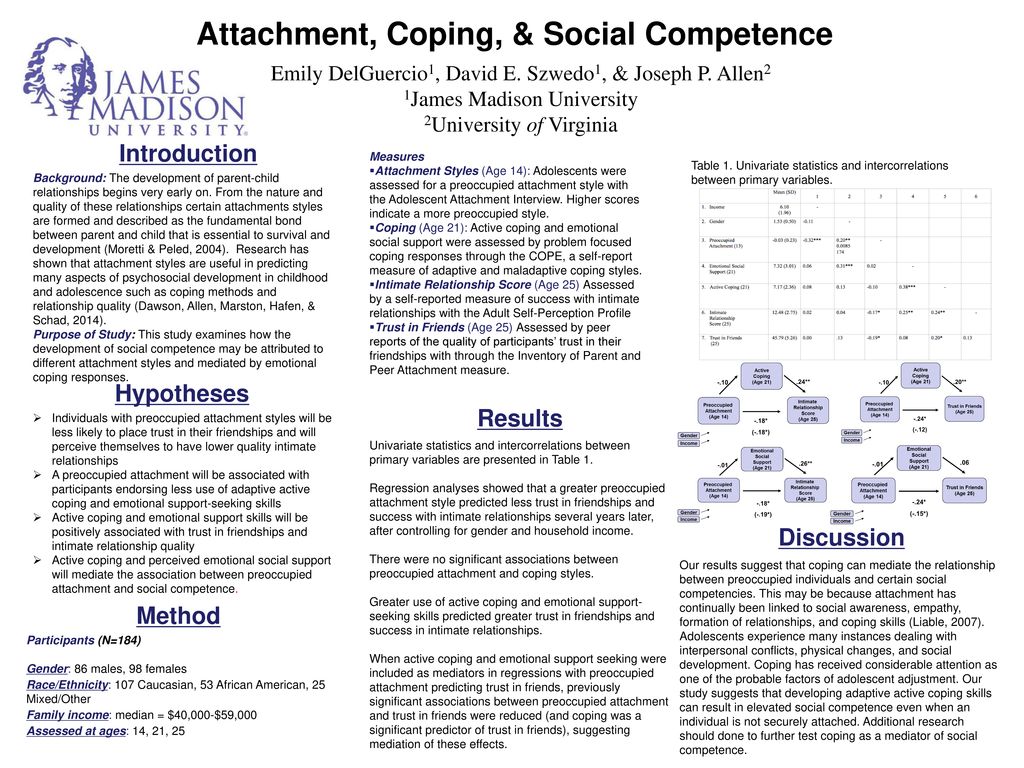 nine0003
nine0003
1. Secure Attachment
“I don't get overwhelmed by emotions, but I don't suppress them either. I communicate easily and just as easily can be alone without losing my calm and enjoying it. I treat my partner's requests with attention and do not perceive them as a threat or an obligation.
This attachment style develops in children who are confident that a significant adult will always be there when needed and will provide assistance. This confidence allows them to feel safe and explore the world around them with interest. They enjoy intimacy and are not dependent. nine0003
2. Detached or avoidant insecure attachment
“I avoid close relationships, I tend to be distrustful, I find it difficult to express my feelings, turn to others for help or advice. Partners I usually perceive as disinterested or detached. I don't want to be rejected, so I pretend I don't need affection."
This style of attachment occurs when the child's calls are not answered and the needs are not met.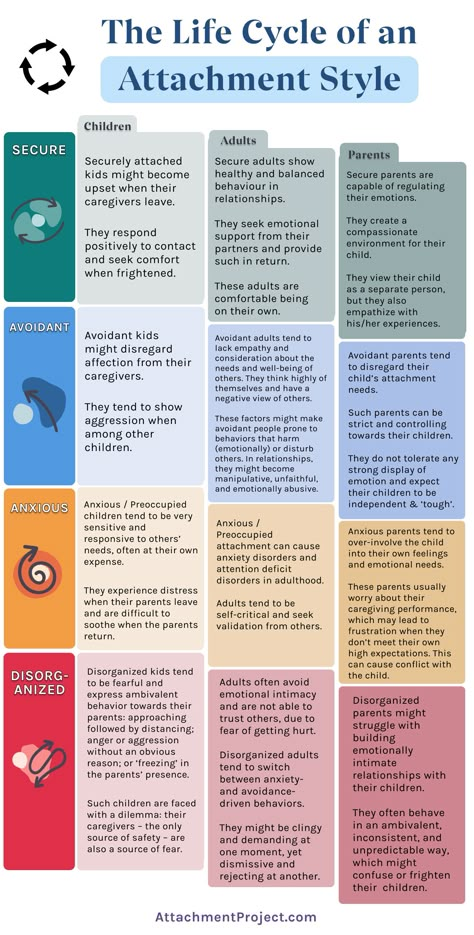 The child concludes that his desires are indifferent to an adult, and tries to adapt to this situation, suppressing his need for love and care. He may look indifferent and uninterested, but behind this lies the fear of rejection and grief. nine0003
The child concludes that his desires are indifferent to an adult, and tries to adapt to this situation, suppressing his need for love and care. He may look indifferent and uninterested, but behind this lies the fear of rejection and grief. nine0003
3. Restless or anxious insecure attachment
“I often feel anxiety, jealousy gnaws at me, overwhelmed by emotions that I cannot cope with. I'm afraid of becoming addicted or being seen as obsessive. Then I try to withdraw into myself, but soon I get lonely and anxious, and everything repeats.
This style of attachment is a consequence of the unpredictable behavior of an adult: he is either rude, or gentle, or indifferent. It may suddenly leave, leaving the child, but he does not understand what it depends on and what to expect. Such children are afraid of strangers even in the presence of a parent, they are very upset when the parent leaves, but they are not happy when he returns. And sometimes they even get angry at him because they don't feel safe with him.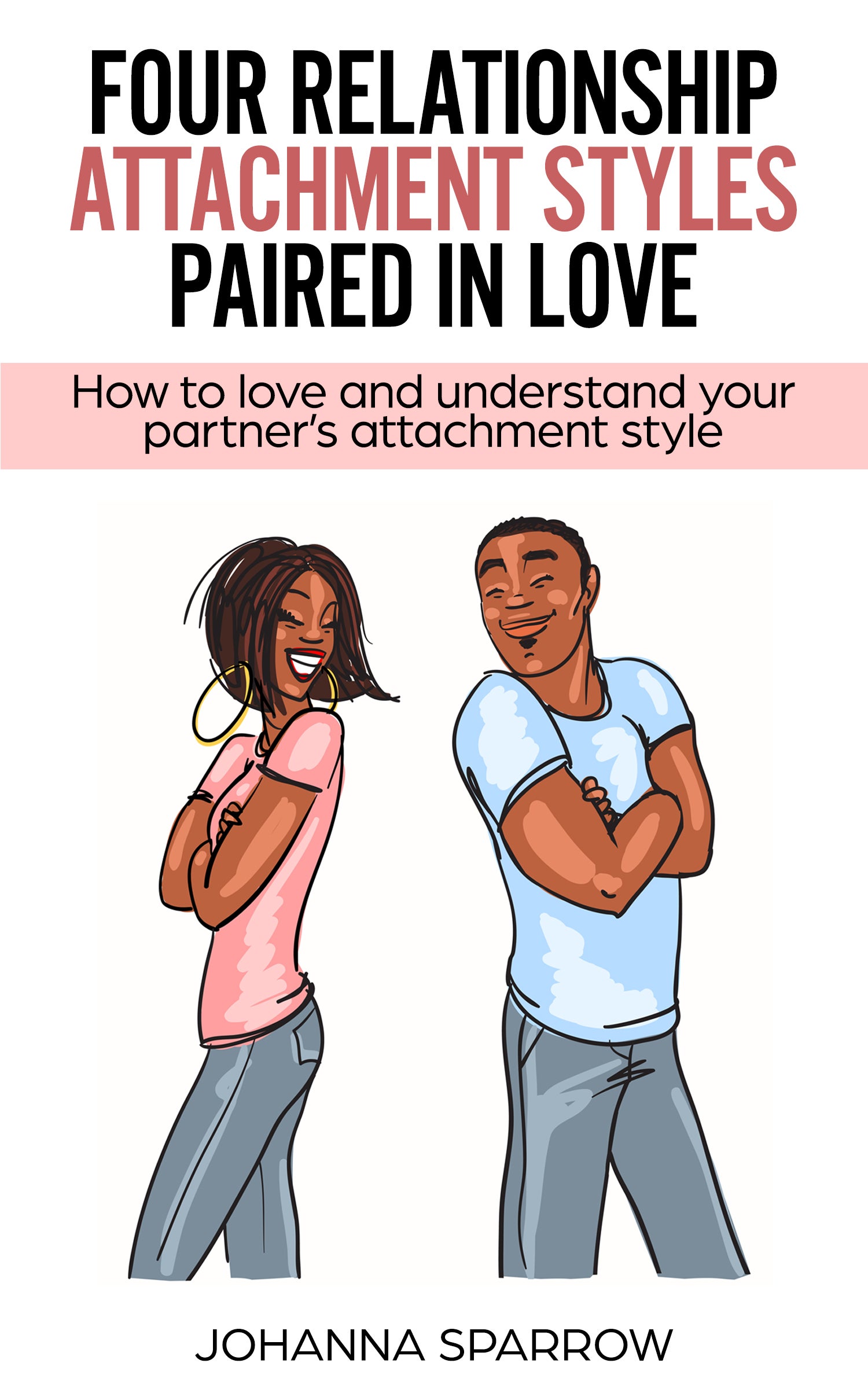 nine0003
nine0003
4. Fearful attachment
“I am lonely because of mistrust. Close relationships scare me, but I also fear being alone and need moral support. I am extremely sensitive to rejection, and it is difficult for me to assert myself.
This attachment style occurs in children who are used to suppressing their feelings, not meeting with a significant adult for help and approval, withstanding ridicule and intimidation from a significant adult.
Read more in J. Bowlby's book Making and Breaking Emotional Ties (Academic Project, 2006). nine0038
Text: Elza Lestvitskaya
New on the site
“Every time a relationship got serious, I left. Why?"
“I regret that I confessed to my husband that I had cheated. How to restore good relations?
Incubi, sacrifices and orgies: what is sexual magic - dive into the story
How to recognize a womanizer: 10 signs - check your partner
New Year's aggravation: why we get dreary before the holidays0004 “For 15 years I have not found a girlfriend on dating sites”
Joint birth: harm or benefit for relationships?
Where does the fear of death come from and how to overcome it?
4 Styles of Attachment - Institute for Family Development
Does your partner avoid intimacy? On the contrary, obsessive? Or perhaps inconsistent and unpredictable? Or is he reliable, gentle, and relationships with him bring peace and satisfaction? One approach to explaining the reasons for such behavior is to determine the attachment style that a person developed in childhood.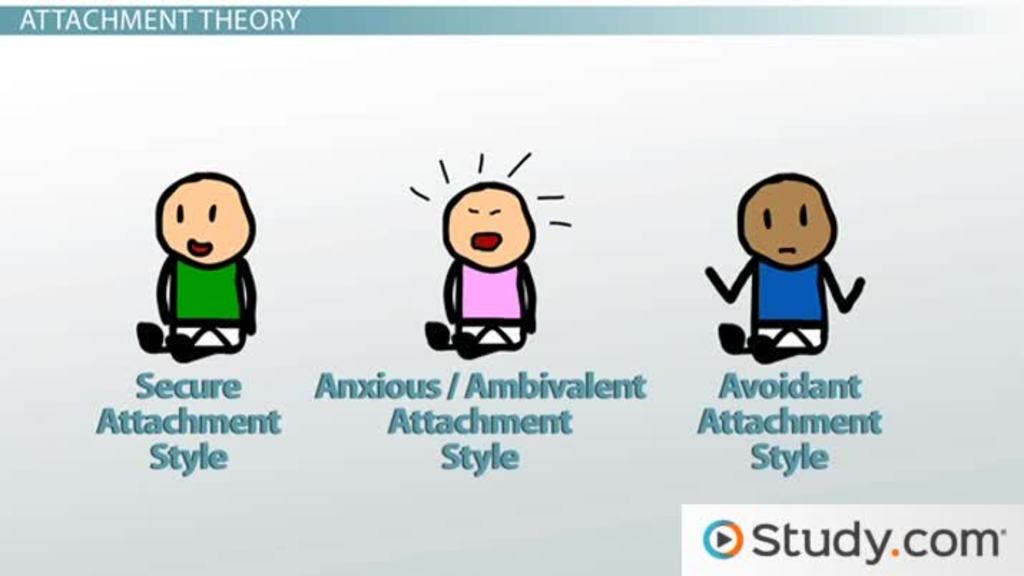 nine0003
nine0003
We continue to introduce you to psychologists who have studied attachment. It's about Mary Ainsworth. It was she who described 4 styles of attachment.
Born in the USA in 1913, Mary Ainsworth is one of the 100 most influential psychologists of the 20th century. Ainsworth is an American-Canadian scientist who worked, among other things, with John Bowlby. Ainsworth expanded his attachment theory substantially in the 1970s. Her innovation is particularly evident in the creation of a method for assessing attachment in infants aged one to one and a half years to a significant adult - the so-called "Strange Situation" procedure
During the procedure, the mother and child are placed in an unfamiliar playroom with toys. At the same time, the researcher observes them through a one-way mirror. The procedure consists of eight successive stages in which the child experiences a short-term separation from and reunion with the mother, as well as the presence of an unfamiliar adult. (here's an example in the video https://www.youtube.com/watch?v=QTsewNrHUHU)
(here's an example in the video https://www.youtube.com/watch?v=QTsewNrHUHU)
Based on the children's reactions during the experiment, Ainsworth described three main attachment styles: secure, anxious, and avoidant. Ainsworth's colleague, Mary Maine, later described a fourth as disorganized. nine0003
RELIABLE. In the experiment, after the departure of the mother, the child is upset, but quickly calms down when she appears, calmly interacts with strangers in the presence of the mother, looks at the mother during the game and smiles, is proactive and inquisitive.
Secure attachment is formed in children who grow up in close-knit families, where parents constantly maintain emotional contact with their children. The parent is available and able to meet the needs of the child in an appropriate way. Securely attached children feel secure and are more likely to explore their environment. nine0003
In adulthood, people with secure attachments do not alienate their loved ones and become dependent on them.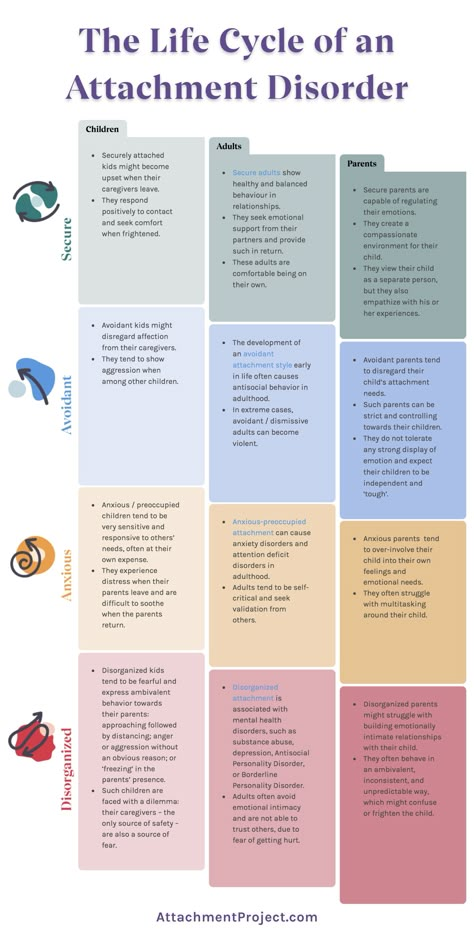 They trust loved ones, feel worthy of love, respect a partner and are ready to seek a compromise. Of course, such people also have problems in relationships, but their cause should not be sought in childhood. The secure type is considered the most adaptive attachment style.
They trust loved ones, feel worthy of love, respect a partner and are ready to seek a compromise. Of course, such people also have problems in relationships, but their cause should not be sought in childhood. The secure type is considered the most adaptive attachment style.
ANXIETY attachment manifests itself in the strong distress of the child after the departure of the mother, crying, hysterics, which do not stop even after her return. Sometimes aggression towards the mother is manifested, refusal to communicate with strangers. The child explores little, is wary of strangers, even in the presence of a parent. nine0003
Anxious attachment is a consequence of the adult's inconsistent behavior, his anxiety about initiatives or the child's health. This type of attachment is formed when parents are unpredictable. They either allow or forbid. Either nearby or not. And the child begins to cling to them, so as not to lose.
People with this type of attachment have low self-esteem.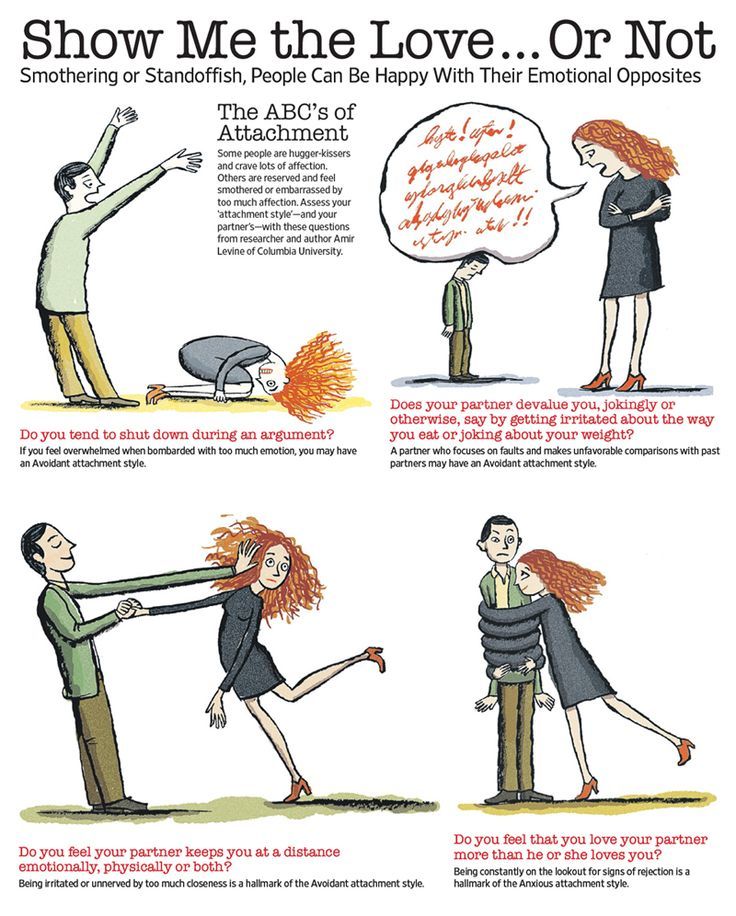 They are dependent, react painfully to changes in relationships, are afraid to be alone and therefore constantly require confirmation of love. nine0003
They are dependent, react painfully to changes in relationships, are afraid to be alone and therefore constantly require confirmation of love. nine0003
AVOIDING attachment is manifested in the child's indifference to the care of the mother, the absence of fear of strangers, a low level of initiative and response behavior. Ainsworth suggested that the deadpan behavior of infants is a disguise for grief. This happens when the child's needs have not been taken into account, and he comes to the conclusion that the satisfaction of his needs does not matter to the significant adult.
Avoidant attachment is formed when a child has experienced attachment denial, when parents reject the child, do not respond to his needs, do not support him emotionally, or when prohibitive forms of upbringing prevail. nine0003
Then a person in adult life usually avoids close relationships, keeps a partner at a distance, and also, as a rule, hides his feelings. Moreover, despite the closed behavior, such a person really needs relationships and support.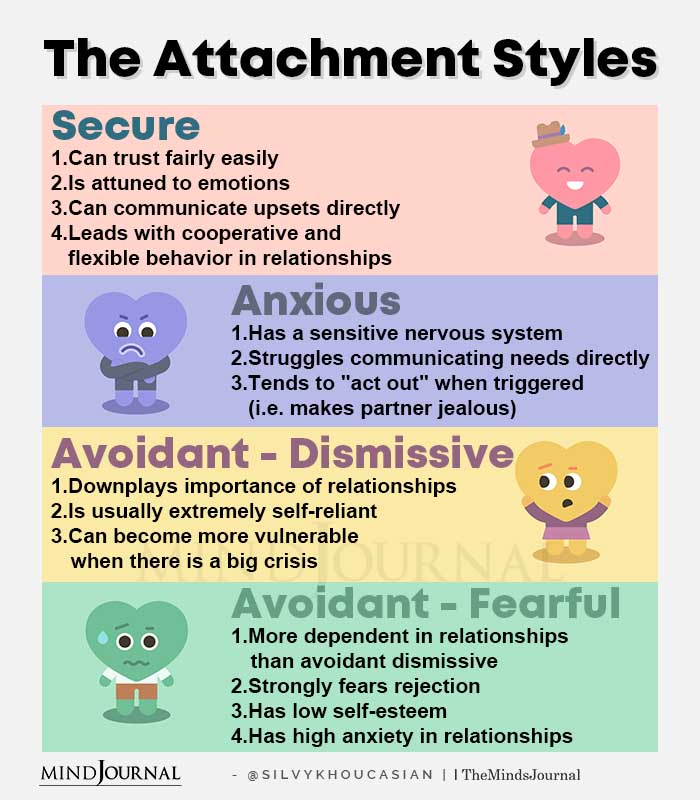 Without them, he feels lonely.
Without them, he feels lonely.
DISORIENTED attachment is expressed in the absence of connection of behavior with the stages of achieving intimacy. Such attachment includes overt manifestations of fear; conflicting behaviour. Children may run to hide when they see a significant adult, or exhibit avoidant or ambivalent strategies when reunited with a parent. This is an indication that the attachment system has been disturbed (for example, by fear or anger)
Disoriented attachment is often formed in families where the child is exposed to violence. These children break the rules of human relations by forgoing attachment in favor of power: they don't need to be loved, they prefer to be feared. Their behavior is inconsistent and often change. A person with a disoriented sense of attachment can seek a relationship for a long time, and having achieved it, immediately drop everything and break it off.
***
According to Ainsworth, attachment style is not so much a part of a child's thinking as a characteristic feature of relationships.